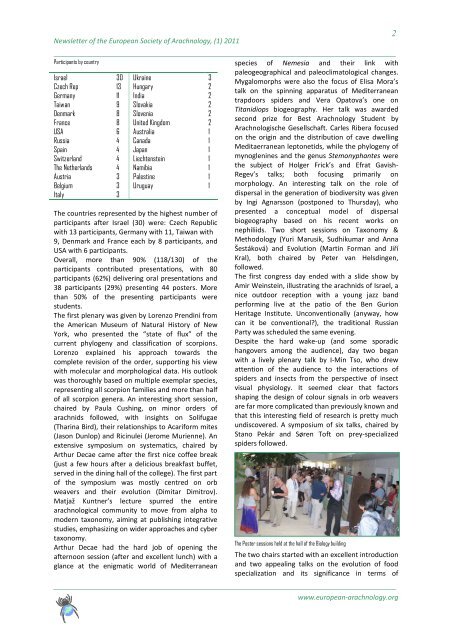Newsletter 1 - European Society of Arachnology
Newsletter 1 - European Society of Arachnology
Newsletter 1 - European Society of Arachnology
You also want an ePaper? Increase the reach of your titles
YUMPU automatically turns print PDFs into web optimized ePapers that Google loves.
<strong>Newsletter</strong> <strong>of</strong> the <strong>European</strong> <strong>Society</strong> <strong>of</strong> <strong>Arachnology</strong>, (1) 2011<br />
___________________________________________________________________________<br />
Participants by country<br />
Israel 30 Ukraine 3<br />
Czech Rep 13 Hungary 2<br />
Germany 11 India 2<br />
Taiwan 9 Slovakia 2<br />
Denmark 8 Slovenia 2<br />
France 8 United Kingdom 2<br />
USA 6 Australia 1<br />
Russia 4 Canada 1<br />
Spain 4 Japan 1<br />
Switzerland 4 Liechtenstein 1<br />
The Netherlands 4 Namibia 1<br />
Austria 3 Palestine 1<br />
Belgium 3 Uruguay 1<br />
Italy 3<br />
The countries represented by the highest number <strong>of</strong><br />
participants after Israel (30) were: Czech Republic<br />
with 13 participants, Germany with 11, Taiwan with<br />
9, Denmark and France each by 8 participants, and<br />
USA with 6 participants.<br />
Overall, more than 90% (118/130) <strong>of</strong> the<br />
participants contributed presentations, with 80<br />
participants (62%) delivering oral presentations and<br />
38 participants (29%) presenting 44 posters. More<br />
than 50% <strong>of</strong> the presenting participants were<br />
students.<br />
The first plenary was given by Lorenzo Prendini from<br />
the American Museum <strong>of</strong> Natural History <strong>of</strong> New<br />
York, who presented the “state <strong>of</strong> flux” <strong>of</strong> the<br />
current phylogeny and classification <strong>of</strong> scorpions.<br />
Lorenzo explained his approach towards the<br />
complete revision <strong>of</strong> the order, supporting his view<br />
with molecular and morphological data. His outlook<br />
was thoroughly based on multiple exemplar species,<br />
representing all scorpion families and more than half<br />
<strong>of</strong> all scorpion genera. An interesting short session,<br />
chaired by Paula Cushing, on minor orders <strong>of</strong><br />
arachnids followed, with insights on Solifugae<br />
(Tharina Bird), their relationships to Acariform mites<br />
(Jason Dunlop) and Ricinulei (Jerome Murienne). An<br />
extensive symposium on systematics, chaired by<br />
Arthur Decae came after the first nice c<strong>of</strong>fee break<br />
(just a few hours after a delicious breakfast buffet,<br />
served in the dining hall <strong>of</strong> the college). The first part<br />
<strong>of</strong> the symposium was mostly centred on orb<br />
weavers and their evolution (Dimitar Dimitrov).<br />
Matjaž Kuntner’s lecture spurred the entire<br />
arachnological community to move from alpha to<br />
modern taxonomy, aiming at publishing integrative<br />
studies, emphasizing on wider approaches and cyber<br />
taxonomy.<br />
Arthur Decae had the hard job <strong>of</strong> opening the<br />
afternoon session (after and excellent lunch) with a<br />
glance at the enigmatic world <strong>of</strong> Mediterranean<br />
species <strong>of</strong> Nemesia and their link with<br />
paleogeographical and paleoclimatological changes.<br />
Mygalomorphs were also the focus <strong>of</strong> Elisa Mora’s<br />
talk on the spinning apparatus <strong>of</strong> Mediterranean<br />
trapdoors spiders and Vera Opatova’s one on<br />
Titanidiops biogeography. Her talk was awarded<br />
second prize for Best <strong>Arachnology</strong> Student by<br />
Arachnologische Gesellschaft. Carles Ribera focused<br />
on the origin and the distribution <strong>of</strong> cave dwelling<br />
Meditaerranean leptonetids, while the phylogeny <strong>of</strong><br />
mynoglenines and the genus Stemonyphantes were<br />
the subject <strong>of</strong> Holger Frick’s and Efrat Gavish-<br />
Regev’s talks; both focusing primarily on<br />
morphology. An interesting talk on the role <strong>of</strong><br />
dispersal in the generation <strong>of</strong> biodiversity was given<br />
by Ingi Agnarsson (postponed to Thursday), who<br />
presented a conceptual model <strong>of</strong> dispersal<br />
biogeography based on his recent works on<br />
nephiliids. Two short sessions on Taxonomy &<br />
Methodology (Yuri Marusik, Sudhikumar and Anna<br />
Šestáková) and Evolution (Martin Forman and Jiří<br />
Kral), both chaired by Peter van Helsdingen,<br />
followed.<br />
The first congress day ended with a slide show by<br />
Amir Weinstein, illustrating the arachnids <strong>of</strong> Israel, a<br />
nice outdoor reception with a young jazz band<br />
performing live at the patio <strong>of</strong> the Ben Gurion<br />
Heritage Institute. Unconventionally (anyway, how<br />
can it be conventional?), the traditional Russian<br />
Party was scheduled the same evening.<br />
Despite the hard wake-up (and some sporadic<br />
hangovers among the audience), day two began<br />
with a lively plenary talk by I-Min Tso, who drew<br />
attention <strong>of</strong> the audience to the interactions <strong>of</strong><br />
spiders and insects from the perspective <strong>of</strong> insect<br />
visual physiology. It seemed clear that factors<br />
shaping the design <strong>of</strong> colour signals in orb weavers<br />
are far more complicated than previously known and<br />
that this interesting field <strong>of</strong> research is pretty much<br />
undiscovered. A symposium <strong>of</strong> six talks, chaired by<br />
Stano Pekár and Søren T<strong>of</strong>t on prey-specialized<br />
spiders followed.<br />
The Poster sessions held at the hall <strong>of</strong> the Biology building<br />
The two chairs started with an excellent introduction<br />
and two appealing talks on the evolution <strong>of</strong> food<br />
specialization and its significance in terms <strong>of</strong><br />
_______________________________________________________________________<br />
www.european-arachnology.org<br />
2
















